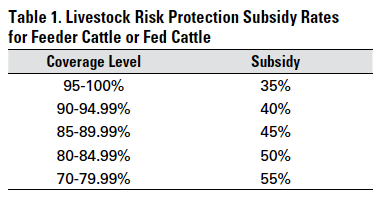Raise Your Competence with Bagley Risk Management
Raise Your Competence with Bagley Risk Management
Blog Article
Trick Elements to Think About When Deciding On Animals Risk Protection (LRP) Insurance Coverage
When reviewing options for Livestock Risk Protection (LRP) insurance, several essential aspects necessitate mindful factor to consider to make certain effective risk management in the farming field. Picking the appropriate insurance coverage choices customized to your certain livestock operation is paramount, as is understanding just how exceptional prices associate with the level of protection offered. In addition, the qualification requirements for different sorts of livestock and the adaptability of the plan to adapt to altering situations are vital aspects to weigh. The performance and openness of the insurance claims process can dramatically affect the overall experience and financial end results for animals producers. By purposefully browsing these crucial elements, manufacturers can secure their financial investments and mitigate possible risks properly.
Coverage Options
When thinking about Animals Risk Security (LRP) insurance policy, it is necessary to recognize the various protection choices readily available to mitigate risks in the agricultural field. Animals Risk Security (LRP) insurance coverage supplies different protection choices customized to meet the varied demands of animals manufacturers. Bagley Risk Management. One of the key protection choices is rate protection, which protects against a decrease in market value. Manufacturers can pick the coverage level that straightens with their price threat monitoring goals, permitting them to safeguard their operations versus potential economic losses.
An additional essential coverage option is the recommendation duration, which determines the size of time the coverage is in result. Manufacturers can select the endorsement period that ideal matches their manufacturing cycle and market problems. In addition, insurance coverage levels and prices differ based on the kind of livestock being insured, offering producers the adaptability to personalize their insurance coverage intends according to their certain demands.
Understanding the various coverage alternatives offered under Livestock Danger Protection (LRP) insurance is important for manufacturers to make informed choices that efficiently shield their livestock procedures from market uncertainties.
Costs Prices

Livestock Risk Security (LRP) insurance coverage gives important protection choices customized to minimize threats in the agricultural industry, with a considerable element to take into consideration being the estimation and framework of premium costs. When establishing premium costs for LRP insurance, a number of variables come right into play. These include the type and number of livestock being insured, the protection degree picked, the current market prices, historical rate information, and the size of the insurance coverage period. Insurance providers might likewise think about the place of the ranch, as geographical aspects can influence the general danger account.
Premium expenses for LRP insurance coverage are commonly computed based on actuarial data and risk assessment models. Insurance providers analyze historical information on animals costs and production prices to establish an ideal costs that mirrors the level of risk involved. It is essential for livestock manufacturers to carefully review premium expenses and coverage options to guarantee they are effectively protected versus potential economic losses because of unfavorable market conditions or unpredicted occasions. By understanding exactly how premium expenses are calculated and structured, producers can make educated choices when selecting the ideal LRP insurance policy for their procedure.
Eligible Livestock
The determination of eligible animals for Animals Danger Defense (LRP) insurance policy protection entails careful factor to consider of details standards and features. Animals types that are normally eligible for LRP insurance consist of feeder cattle, fed swine, lambs, and livestock.
Feeder cattle, for instance, are generally eligible for LRP coverage if they drop within specified weight varieties. Lambs are another group of animals that can be click here for more info considered for LRP insurance, with elements such as weight and age playing a crucial function in establishing their eligibility.
Prior to picking LRP insurance coverage for animals, manufacturers ought to very carefully review the qualification criteria outlined by the insurance coverage company to ensure their animals satisfy the required demands for coverage.
Plan Adaptability
Plan adaptability in Livestock Risk Defense (LRP) insurance coverage allows manufacturers to customize insurance coverage to fit their particular needs and risk management strategies. This flexibility empowers animals producers to customize their insurance plans based on aspects such as the type of livestock they possess, market conditions, and specific threat tolerance levels. By offering adjustable alternatives, LRP insurance policy makes it possible for producers to successfully manage their threat exposure while guarding their livestock operations against unanticipated market volatility.
Claims Process
Upon experiencing a loss or damages, manufacturers can initiate the insurance claims procedure for their Animals Risk Security (LRP) insurance policy by quickly contacting their insurance policy company. It is critical for manufacturers to report the loss as quickly as possible to speed up the insurance claims procedure. When connecting to the insurance policy supplier, manufacturers will certainly require to offer in-depth info concerning the case, including the date, nature of the loss, and any relevant paperwork such as veterinary records or market costs.

After the assessment is full, the insurance copyright will make a choice relating to the claim and interact the outcome to the manufacturer. If the case is authorized, the manufacturer will obtain compensation according to the regards to their Animals Danger Defense (LRP) insurance plan. Bagley Risk Management. It is vital for manufacturers to be aware of the claims process to make certain a smooth experience in find case of a loss

Conclusion
In conclusion, when selecting Livestock Threat Defense (LRP) insurance, it is necessary to consider coverage options, premium prices, qualified animals, policy versatility, and the claims process. These key factors will certainly aid make sure that breeders and farmers are sufficiently safeguarded against possible threats and losses related to their livestock procedures. Making an educated choice based on these factors to consider can eventually result in better financial security and satisfaction for livestock producers.
Animals Danger Security (LRP) insurance supplies various protection options customized to why not try this out satisfy the diverse requirements of animals manufacturers.The determination of qualified animals for Livestock Threat Security (LRP) insurance protection includes careful factor to consider of particular criteria and attributes.Policy adaptability in Animals Risk Defense (LRP) insurance permits producers to customize coverage to fit their specific requirements and risk administration strategies.Upon experiencing a loss or damage, manufacturers can initiate the insurance claims procedure for their Livestock Danger Protection (LRP) insurance coverage by without delay calling their insurance policy service provider.In final thought, when choosing Animals Risk Security (LRP) insurance policy, it is essential to think about insurance coverage options, premium expenses, qualified animals, plan flexibility, and the insurance claims procedure.
Report this page